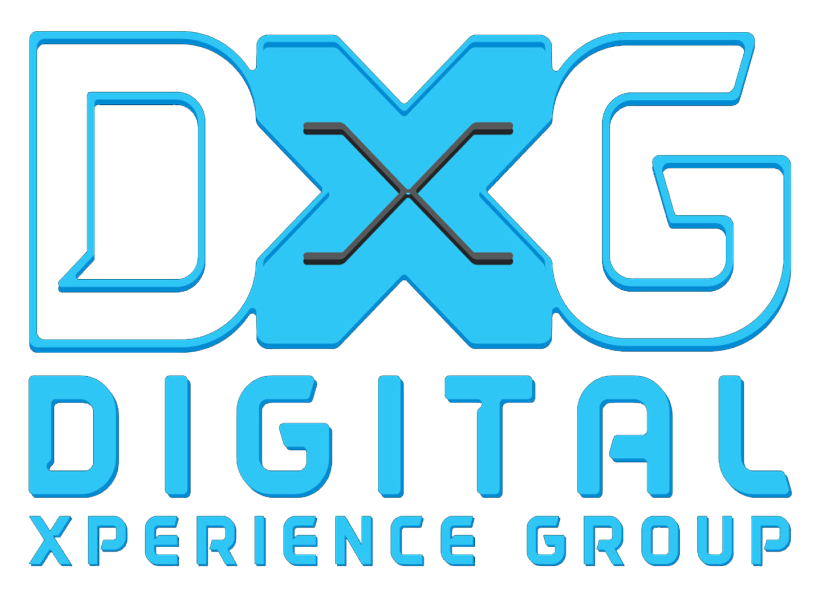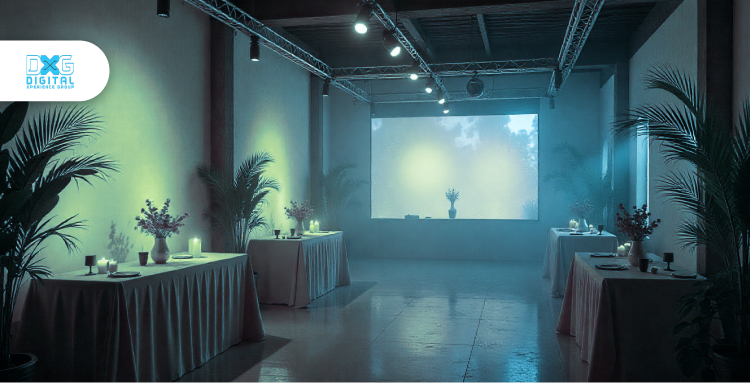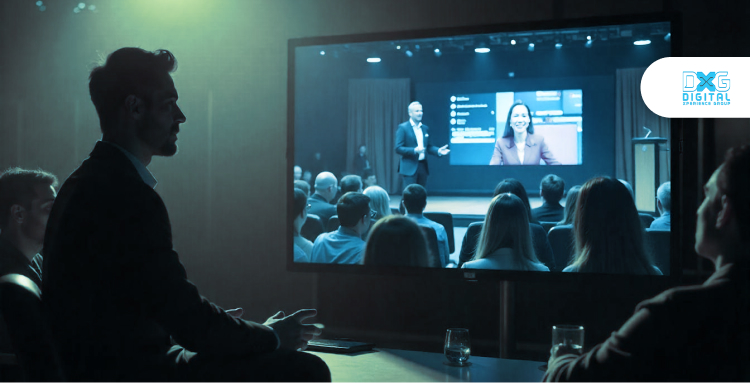


April 15, 2025
Did you know that by 2025, the global virtual events market is expected to hit approx $230 billion? That’s nearly a quarter of a trillion dollars spent on online conferences, hybrid summits, and immersive digital experiences. Just a few years ago, we were all stuck in awkward Zoom meetings, trying to figure out how to unmute ourselves. Now, we’re stepping into holographic networking sessions, AI-powered event planning, and metaverse weddings where guests show up as avatars.
The way we host and attend events is changing at lightning speed. It’s not just about booking a venue and sending out invites anymore—it’s about creating unforgettable, immersive experiences that blend the physical and digital worlds. So, if you're an event planner, business owner, or just someone who loves being part of incredible gatherings, buckle up to explore the most cutting-edge, jaw-dropping event ideas for 2025.
So, what’s cooking in the event world as we roll into 2025? The best events don’t just happen—they create experiences that stick with people long after they’re over. Here are 5 innovative ideas to make your next event unforgettable.
Integration of Artificial Intelligence (AI)
Ever been to an event where you spent half your time figuring out which sessions to attend, only to realize later that you missed the most valuable ones? AI is changing that.
Let’s say an event app that analyzes your interests and past event behavior to suggest the perfect sessions, networking opportunities, and even lunch spots (because let’s be real, food matters). AI-driven tools can also track attendee engagement in real time, helping organizers tweak schedules, adjust room capacities, and send personalized recommendations instantly.
Rise of Phygital Experiences
For instance, you’re at a product launch event where in-person attendees test out a new gadget while remote participants control a robotic arm that interacts with the same product in real time. Or a conference where a virtual attendee’s question gets displayed on a holographic screen, making them feel like they’re right there in the room.
The 2024 Games of the Future in Russia introduced phygital sports, where athletes competed in both physical and esports challenges, seamlessly integrating real-world and virtual elements. This concept is now making its way into mainstream events.
Virtual and Augmented Reality (VR/AR)
We’ve all seen VR and AR pop up at events, however in 2025, these technologies are actually enhancing engagement, not just providing a cool factor.
VR Networking Lounges: Instead of awkwardly wandering around looking for someone to talk to, attendees can enter a virtual lounge, explore topics, and join group conversations as avatars.
AR Overlays for On-Site Experiences: Imagine pointing your phone at an event banner and seeing 3D animations, interactive schedules, or even a speaker’s bio come to life.
VR for Remote Attendees: No more boring livestreams. Now, remote participants can “walk through” an event in 360-degree VR, interact with booths, and even join live Q&As with speakers.
Check this out: Top Event Audio Visual Trends

Zero-Waste Initiatives
Let’s be honest—traditional events can be wasteful. From plastic cups piling up to energy-hungry venues, the environmental impact adds up fast. But in 2025, sustainability isn’t just a nice-to-have—it’s a must. Zero-waste events aim to eliminate all that unnecessary waste. Here’s how:
Swap single-use plastics for compostable or reusable alternatives (think bamboo cutlery, aluminum water bottles, and digital event badges).
Cut down on paper with QR codes for schedules, digital brochures, and e-tickets.
Work with vendors that provide sustainable catering—say goodbye to plastic-wrapped sandwiches and hello to locally sourced meals served on biodegradable plates.
The Glastonbury Festival banned single-use plastics back in 2019, and by 2025, many large-scale events are following suit. Some conferences are even offering discounts for attendees who bring their own reusable cups and utensils
Carbon-Neutral Events
A big part of an event’s carbon footprint comes from travel, energy use, and waste. But with the right strategies, you can balance out that impact.
Offer carbon offset options—encourage attendees to offset their travel emissions through verified programs.
Use renewable energy—many venues now run on solar, wind, or hydro power. If your venue doesn’t, look into temporary renewable energy solutions like battery-powered stages.
Reduce transportation impact—provide bike racks, shuttle buses, or incentives for carpooling. Better yet, offer a virtual attendance option to cut travel emissions entirely.
You probably have heard that the COP26 climate summit in Glasgow made sustainability a priority by using 100% renewable energy, locally sourced food, and a strict waste management plan. Many event planners are now using similar models.
Local Sourcing and Community Engagement
Flying in catering, décor, and materials from across the world drives up emissions—and costs. A more sustainable approach? Go local. Here’s how:
Partner with local farms, breweries, and restaurants to cut down transportation emissions and support the economy.
Work with local artists and businesses for event décor, gifts, and entertainment.
Engage the local community in event planning—hire local staff, collaborate with schools or charities, and create opportunities for the host city to benefit.

Multi-Sensory Installations
In 2025, it’s all about pulling attendees in with experiences that hit them from every angle and keep them buzzing. multi-sensory experiences can make you feel like you walked into an event space and instantly felt transported. Instead of just relying on visuals, event planners are tapping into sound, scent, touch, and even taste to create unforgettable moments.
Use ambient sounds and curated music to set the mood—think calming nature sounds for wellness events or high-energy beats for product launches.
Introducing interactive scent stations (yes, smell is deeply tied to memory!)—a luxury brand event could diffuse signature fragrances, while a travel expo might use tropical scents to transport attendees to far-off destinations.
Play with textures and tactile experiences—soft seating areas, interactive walls, or even temperature-controlled spaces can heighten engagement.
Gamification
People love games—it’s human nature. So why not bring that into events? Gamification adds an element of fun and competition, making learning and networking feel like an adventure rather than an obligation. Here’s how:
Scavenger hunts—Encourage attendees to visit booths, attend sessions, or network to unlock prizes.
Live leaderboards—Track participation and reward attendees for engagement (e.g., attending sessions, asking questions, or posting on social media).
Escape room challenges—Turn team-building or corporate training into a real-life puzzle that attendees must solve together.
Many conferences now use event apps with built-in gamification, where attendees earn points for engaging and can redeem rewards. This boosts participation while making the event more dynamic.
More for you: Maximizing Audience Engagement with Event Platform Features
Live Art and Performances
Nothing captivates an audience quite like live art. Whether it’s a street artist creating a mural in real-time, a spontaneous dance performance, or an AI-powered digital painting, these interactive moments bring energy and excitement to any event.
Live mural walls—Give attendees a chance to contribute to an evolving art piece throughout the event.
Surprise performances—Instead of a scheduled act, break up sessions with spontaneous music, spoken word, or dance performances.
AI-generated art installations—Let attendees input words or emotions into an AI system that creates custom art on the spot.

Hybrid Event Models
Events in 2025 are no longer just about who can physically show up. Today, a great event is one that welcomes everyone—regardless of location, ability, or background. By blending in-person and virtual experiences, prioritizing accessibility, and embracing diversity, you’re creating a richer, more meaningful event.
Live-stream key sessions with interactive Q&As so remote attendees can engage in real-time.
Create on-demand content so people can catch up on sessions at their convenience.
Hybrid networking spaces—AI-powered matchmaking can connect in-person and virtual attendees for 1:1 chats or group discussions.
Also read: How to Plan a Successful Hybrid Event: Step-by-Step Guide
Accessibility Enhancements
Now, let’s make sure everyone can join the fun. A truly inclusive event ensures that everyone—regardless of physical ability, hearing, vision, or neurodiversity—can fully participate. Here’s how:
Sign language interpreters & closed captions for live and virtual sessions.
Assistive tech like screen readers & voice navigation in event apps and websites.
Quiet zones and sensory-friendly spaces for neurodivergent attendees.
Cultural Sensitivity and Diversity
And then there’s the vibe—who’s on stage and what’s being said. In 2025, it’s all about diversity that actually means something. A diverse event is a better event—not just because it’s the right thing to do, however because it leads to better conversations, insights, and experiences.
Curate diverse speaker lineups—ensure representation across genders, ethnicities, and perspectives.
Offer multilingual support—provide translations, subtitles, and real-time interpreters.
Respect cultural differences—consider time zones, holidays, and dietary needs when planning global events.
Wellness Retreats with AI-Personalized Schedules
Event trends aren’t your run-of-the-mill conferences—they’re niche, they’re fresh, and they’re tapping into what people are obsessed with right now. Wellness isn’t just about yoga and meditation anymore. It’s about personalized self-care—and technology is making it more targeted than ever. At wellness retreats, AI is being used to design personalized schedules based on attendees’ individual goals, preferences, and health data.
AI-powered fitness trackers can adjust your daily workout or suggest recovery activities based on your sleep and stress levels.
Customized meal plans can be created using AI tools that take into account your dietary preferences, allergies, and fitness goals.
Virtual wellness apps and meditation guides can be integrated into the event to provide attendees with real-time feedback on their progress throughout the retreat.
Social Impact & Charity-Driven Event Concepts
In a world where consumers are more socially conscious than ever, many events are focusing on making a positive impact. Charity-driven events not only raise funds for important causes however also bring communities together around shared values and social responsibility. Here’s how:
Ticket sales that go towards charity—instead of focusing on profit, some events offer donation-based entry fees or a portion of their proceeds to fund initiatives like education, healthcare, or environmental sustainability.
Volunteer-driven experiences—attendees can participate in hands-on activities, such as community clean-ups, building homes, or organizing donation drives.
So, there you have it—2025’s event scene is shaping up to be a wild ride. We’ve covered the big shifts: AI personalization, hybrid setups, immersive experiences, eco-friendly moves, and niche ideas. It’s all about hooking people in, keeping it real, and delivering something they’ll be texting their friends about for weeks. Whether you’re dreaming up a zero-waste summit or a space-themed brain bash, 2025 events are less “been there, done that” and more “whoa, I need to be there.”
But let’s be real—pulling this off isn’t a solo gig. DXG team are the pros at turning your wild ideas into reality and trust me, you won’t find anyone better at it. We have the whole package: event planning, that nails every detail, tech experts who can sync VR with a hybrid theme. Our dedicated team makes sure your event doesn’t just happen however it lands. If you want your 2025 event to be unforgettable, contact us today, and let's create something amazing.